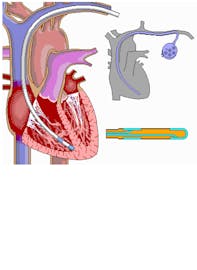Heart Pacemaker

A heart pacemaker can help people with abnormally slow heart beats. It's a device that is battery operated and can sense when the heart beat is irregular or too slow. The pacemaker will send a message to the heart to help it beat at the proper pace. It's made up of two parts: the generator and the leads. The generator holds the battery and the knowledge to control heartbeats. The leads, or wires, link the generator to the heart and send messages electronically to the heart. The pacemaker is placed in the body, under the skin. The generator usually goes below the collarbone, on the left side of the chest. The leads enter the vein and the heart but connect to the generator. The heart is a muscle that is capable of continuous pumping throughout our lifetime. Under ordinary circumstances, this pumping is regular and full. Unfortunately, many diseases and chemicals are capable of influencing the heart and able to produce abnormal rhythms, referred to as arrhythmias. Arrhythmias are either fast and called tachyarrhythmias, or they are slow and are called bradyarrhythmias. A great deal of the tachyarrhythmias can be controlled by cardiac medicines or electrical stimulation of the heart that interferes with the abnormal rhythm and is called defibrillation. Unfortunately, the bradyarrhythmias do not respond as well and often require a mechanical device to create normal contractions of the heart at a rate compatible with providing adequate blood supply to the heart.
Demand pacemakers sense when the heart is sending its own impulses, and work only when the heart fails to beat, or on demand. Fixed-rate pacemakers send impulses to the heart and bring about a continuous steady rate. Unfortunately, microwave ovens tend to interfere with pacemaker actions and should be avoided to ensure proper functioning. Pacemaker rhythms and rates are also capable of being evaluated by phone where technicians and cardiologists are able to receive impulses over phone lines. Technology has certainly advanced this aspect of cardiac care and it is not hard to imagine that the future will see implants and replacement parts for a host of heart abnormalities not necessarily associated with rhythm disorders.


